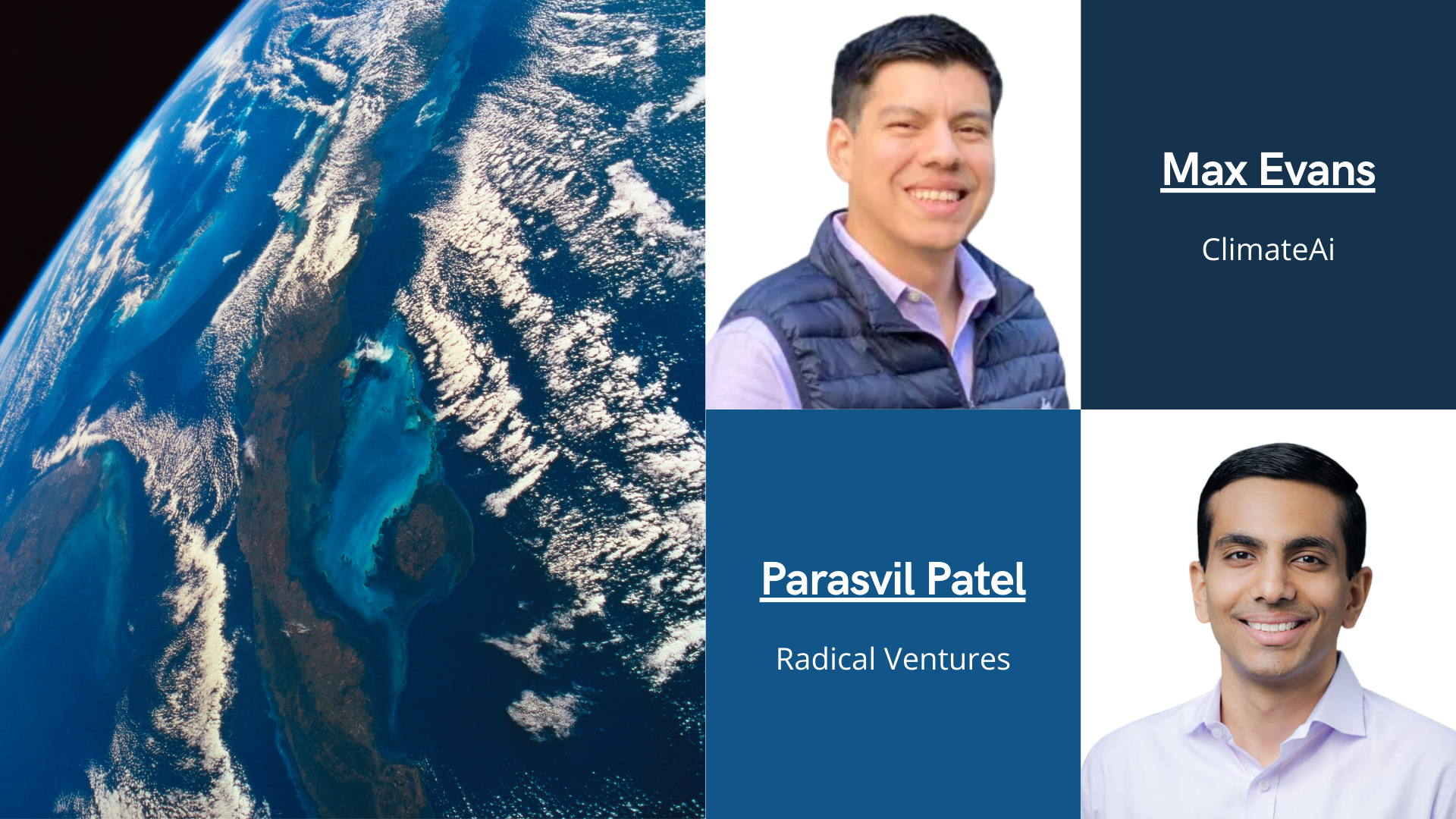ClimateAi is a Radical Ventures portfolio company that has created an AI platform uniquely able to predict weather and climate from 2 weeks to 10+ years in the future. These predictions are made at a localized level enabling businesses to adapt to weather changes and long-term climate shifts. I recently sat down with Max and students in the Master of Science in Applied Computing program at the University of Toronto to discuss research breakthroughs made by ClimateAi, and how AI is helping solve climate challenges. I’ve summarized some of his key takeaways from the talk.
Why start a business applying AI to climate change?
ClimateAi’s driving vision is building climate resilience in our supply chains. The founders started with an interest in understanding how climate change affects assets around the world. Most decision-makers today are using basic weather information based on simple historical extrapolation and coarse signals to make consequential business decisions. A product powered by better data, combined with cutting-edge ML, can dramatically improve the decision making capabilities of business leaders.
How does AI help make climate information more accessible to decision-makers?
ClimateAi’s platform makes insights from our AI models available to businesses that need to make long-term strategic decisions based on climate predictions or granular day-to-day operations decisions based on accurate weather forecasts. For example, ClimateAi’s platform is guiding agriculture companies in planting and harvesting decisions, pinpointing when a seed will germinate and visualizing the process with a software product. We are also capable of going beyond decision-support, capturing novel applications for AI in the climate space through in-house toolsets, and building infrastructure support for data and climate science teams.
What are the recent research breakthroughs underpinning ClimateAi’s models?
ClimateAi has successfully used transfer learning and generative adversarial networks (GANs) to improve weather and climate predictions. Transfer learning makes use of very coarse, low resolution, and sparse datasets by pre-training a neural network on a rich dataset and ‘transferring’ the learning. This method has been used successfully in other disciplines such as self-driving and video games. ClimateAi used a richer data set generated by physical simulations to train a model on the fundamental physics needed to make predictions on Earth observation data such as satellite images. This is new science. Appropriate satellite measurements have only been available for the last ten years and global temperature and precipitation measurements only for the last few decades but we need to predict changes to the weather a few decades out.
ClimateAi researchers have also demonstrated that GANs trained on global weather forecasts can correct for the biases in existing weather models. The new model downscales global forecasts to be as accurate as a local forecast, without requiring the vast amounts of computational, financial, and human resources previously needed for capturing data at such a small scale.
What is the future for the climate and data science field and those interested in contributing to further innovation?
We are still in the early days of applying AI to climate research. Core research questions remain on the foundations of forecasting, downscaling, bias correction, signal processing, determining climate change signals, seasonal signals, and what is ultimately “normal” weather and climate. There is plenty of room for young data scientists to work and push the envelope. As the field continues to grow, specializations are extending beyond natural language processing and image recognition as new types of data such as spatiotemporal data need to be managed with new methods.
ClimateAi was built around making data more accessible to decision-makers and continues to be a pioneer in the climate intelligence space.
AI News This Week
-
The importance of data audits when building AI (VentureBeat)
“As AI-generated insights and predictions become the status quo, the less flashy work of data maintenance can get overlooked. It’s like building a house on sand. It may look fine initially, but as time passes, the structure will collapse.” Pieter Abbeel, UC Berkeley professor, co-founder of Radical Ventures portfolio company Covariant, and host of The Robot Brains podcast, shares his best practices for auditing and maintaining high-quality data. His recommendations include resisting the temptation to outsource data curation and labeling, addressing gaps in incomplete data, and trade-offs between dataset size and speed for obtaining business goals. Creating standard data auditing processes is a must-do step for all businesses looking to gain insights from AI.
-
Genentech-partnered Genesis Therapeutics inks newest AI discovery deal with Eli Lilly (Endpoints News)
Pharmaceutical giant Eli Lilly’s latest investment is in an AI-based drug discovery platform designed to pinpoint and isolate drug candidates for a variety of severe diseases. The partnership between Eli Lilly and Radical Ventures portfolio company Genesis Therapeutics brings together world-class research and development teams to discover novel drugs for patients suffering with severe diseases. Pharmaceutical companies are increasingly investing in AI as the technology is proving to be an indispensable part of the drug discovery process.
-
Which animal viruses could infect people? Computers are racing to find out. (The New York Times)
Researchers at Georgetown University have spent the past few years programming computers to teach themselves about viruses that can infect human cells. The researchers used data on the biology and ecology of host animals for viruses and the genomes and other features of the viruses. The goal is to generate accurate predictions about which viruses are most likely to infect humans and intervene before they do. Machine learning is suited to this task because there are far too many animal viruses for virologists to study. Some researchers estimate that mammals may carry hundreds of thousands of viruses. By applying AI to this challenge, the aim is to spot hidden patterns in the data and guide human virologists to study those animal viruses which present the greatest threat to humans.
-
How hospitals are using AI to save lives (The Wall Street Journal)
Detecting subtle but serious changes in a patient’s condition is difficult in a busy hospital setting. Early-warning systems are a promising area where AI can improve outcomes in hospitals. Patients in the emergency room, inpatient wards, and intensive-care units at the highest risk for dangers such as sepsis, cardiac arrest, and stroke can be flagged for immediate assistance. For sepsis treatment, early recognition and treatment have reduced mortality across 160 hospitals by almost 30%.
In designing new algorithms, data scientists are collaborating with clinical staff to determine what predictive models can be most useful to them and how they can fit into the patient-care flow. For example, to minimize alert fatigue and false alarms the results are monitored remotely by specially trained nurses to reduce workflow interruptions to bedside nurses. Last month Radical Ventures announced our investment in Signal 1. The company’s first application, CHARTWatch, is a machine-learning-based real-time risk predictor that alerts clinicians when it identifies a patient at high-risk for clinical deterioration. Early evidence shows that CHARTWatch reduces mortality rates and shortens hospital stays.
-
Machine learning helps see into a volcano’s depths (Eos)
Some volcanoes erupt frequently but change their behaviour from explosive to effusive. For the tens of millions worldwide who live near volcanoes, anticipating not only when a volcano will erupt but also the severity of the eruption is crucial for effective planning. Researchers have shown hierarchical clustering, an unsupervised machine learning technique, can successfully analyze the number of crystals in the “plumbing system” underneath a volcano to improve behaviour predictions.
Radical Reads is edited by Leah Morris (Senior Director, Velocity Program, Radical Ventures).

